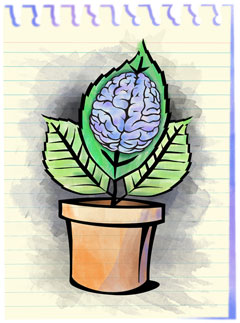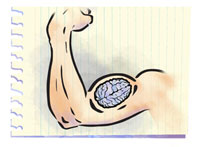Stretching the Limits of Neuroplasticity
By Erin Thacker
 Someday soon, we may be able to repair the brain damage from Alzheimer’s, erase traumatic memories, and access untapped reserves of potential in our minds. The key to altering our brains for the better is the insight—just a few decades old—that the brain constantly remodels itself.
Someday soon, we may be able to repair the brain damage from Alzheimer’s, erase traumatic memories, and access untapped reserves of potential in our minds. The key to altering our brains for the better is the insight—just a few decades old—that the brain constantly remodels itself.
Throughout our lives, from infancy to old age, our brains add connections over here, prune others over there, and ramp up production of certain genes while silencing others. As researchers tease out the intricacies of this process, however, they also are learning how to engineer it from the outside.
Plastic People
“Neural plasticity is perhaps the most powerful capacity your brain has,” says David Sweatt, Ph.D., chair of the UAB Department of Neurobiology, director of the Evelyn F. McKnight Brain Institute at UAB, and Evelyn F. McKnight Endowed Chair for Learning and Memory in Aging. “It’s a huge component of what makes us unique, and what makes us so flexible in our ability to adapt in both positive and negative ways to what’s going on around us.”
UAB already is recognized as a global leader in neuroplasticity research, Sweatt says. Now neuroplasticity is listed as a priority in the School of Medicine’s new strategic plan, which helps chart the future of research at UAB. “The brain, generally speaking, and plasticity of the nervous system, more specifically, is one of the last great frontiers in science and biomedicine,” Sweatt says.
Here is a sampling of the intriguing avenues UAB researchers are exploring now.
Desire Makes a Difference: Training the Brain to Repair Itself
In the 1990s, UAB stroke researcher Edward Taub, Ph.D., in collaboration with a group of German investigators, demonstrated that brain plasticity occurs in humans and can have a functional role in sensory experience and movement. He then provided the first concrete evidence that medical treatments can reshape the brain. Over several decades, and despite considerable early skepticism from colleagues, Taub developed constraint-induced movement therapy (CI therapy) to help patients after a stroke. By immobilizing a patient’s functional arm and encouraging the patient to complete tasks with the impaired limb, therapists have been able to produce dramatic results.
|
CI therapy, originally developed to treat patients after stroke, has been successfully adapted for a number of conditions, including multiple sclerosis. |
Brain imaging techniques show that CI therapy leads to “a profuse increase in the gray matter of the brain in motor areas and in the hippocampus,” Taub says. Patients can benefit from CI therapy even if it begins decades after an injury. The therapy requires no surgery or drugs, and there are no side effects. There is one catch, though: Patients must actively participate in their rehabilitation to gain lasting benefits.
“Passive stimulation does not rewire the brain,” Taub says. “Most rehabilitation therapy is, in a sense, passive. People participate, and they move, but they move in response to what the therapist is telling them to do, and their responsibility ends there.”
CI therapy, by contrast, makes patients the key agent in regaining lost motor function by requiring that they continue extensive use of the impaired arm in everyday tasks when they are outside the clinic. “The patients are thereby immersed in a therapeutic environment for a substantial portion of the day,” Taub says. Over the past decade, stroke patients around the world have benefited from the therapy. Taub and his colleagues have successfully rehabilitated patients with traumatic brain injuries and children with cerebral palsy as well.
 Now Taub is working with Victor Mark, M.D., an associate professor in the UAB Department of Physical Medicine and Rehabilitation, and Gitendra Uswatte, Ph.D., associate professor in the Department of Psychology, to demonstrate the power of CI therapy in patients with multiple sclerosis (MS).
Now Taub is working with Victor Mark, M.D., an associate professor in the UAB Department of Physical Medicine and Rehabilitation, and Gitendra Uswatte, Ph.D., associate professor in the Department of Psychology, to demonstrate the power of CI therapy in patients with multiple sclerosis (MS).
Unlike stroke or traumatic brain injury, MS is a progressive, degenerative neurological disorder, and at first, Taub and his colleagues weren’t positive that CI therapy would provide any benefit. To their delight, however, MS patients can regain some of their lost function immediately after starting CI therapy, and this improvement persists over time, Taub says.
“If anything, we get a better result with MS than we do with stroke, and for the motor functions we train it has prevented the progress of the motor deficit which normally occurs,” Taub explains. “We seem to be getting the same change in gray matter that we do after stroke as well.” The improvements remain up to five years after treatment—the longest observation that researchers have made so far.
Taub, in collaboration with Margaret Johnson, Ph.D., of the University of Montevallo and Jamie Wade and Leslie Harper of the UAB Department of Rehabilitation’s Speech and Hearing Program, also is seeing benefits in patients with aphasia, a language disorder that can result from brain injury. In the few patients treated so far at UAB, CI therapy seems to be very effective at improving the ability to speak. And in work with psychology graduate student Michelle Haddad, Taub has shown that the therapy increases gray matter in language areas of the brain.
Next: The key to manipulating memories